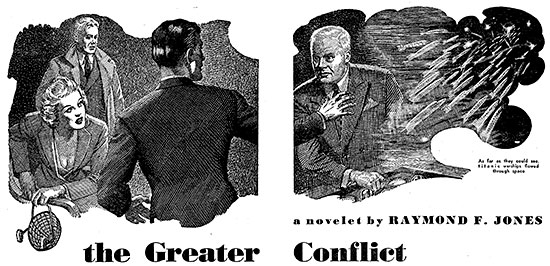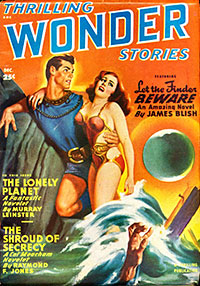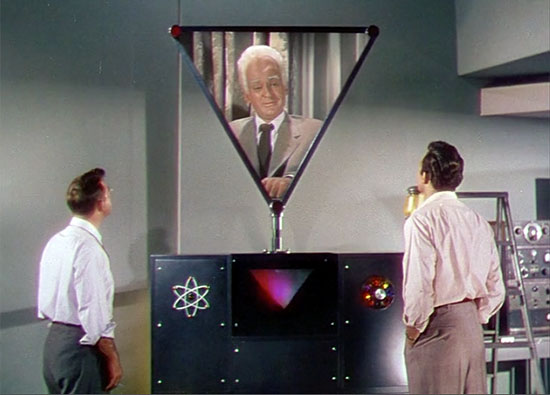
When I saw that actor Rex Reason had died last month, the news brought back fond memories of watching This Island Earth as a teenager in the ’70s. Back then, late nights on Friday and Saturday television were devoted to old movies before the TV stations signed off the air. (Remember that?)
This Island Earth from 1955 was one of the stand-out movies among the many low-grade horror and science fiction that often showed up on local TV at that late hour. Of course, this was before home video tape recorders — let alone DVRs. So when it aired, it was always worth watching.
I vaguely knew that the movie was based on a novel, but I hadn’t read it. The Rex Reason news sent me online to find out more about it. Turns out the story by Raymond F. Jones originally ran in Thrilling Wonder Stories. Sometimes referred to as the “Peace Engineers Trilogy,” the three novelettes appeared in the June and December 1949, and February 1950 numbers of that pulp magazine.
A quick search showed that the three issues had been scanned and were available in comic book reader — .cbr — format online. So I promptly downloaded them and copied them to my iPad for reading during our Thanksgiving travels.

The trilogy — “The Alien Machine,” “The Shroud of Secrecy,” and “The Greater Conflict” — is familiar to anyone who has seen the movie (at least until the action leaves Earth).
In “The Alien Machine,” we meet Cal Meacham, a hot-shot engineer at Ryberg Instrument Corp. on the East Coast. After electronic parts that he’d ordered are replaced with smaller, unfamiliar components from a mysterious Electronic Service, Unit 16, he asks for more details about them and is sent a catalog printed on some futuristic, indestructible paper.
The back of the catalog lists “a complete line of interocitor components. In the following pages you will find complete descriptions of components which reflect the most modern engineering advances known to interocitor engineers.” Meacham promptly orders the parts, and when they arrive, begins to assemble them using the catalog as a guide.
After some trial and error, the interocitor is completed, and Meacham switches it on. The interocitor that he has built turns out to be a communication device. The man on the other end congratulates Meacham for successfully completing the test and offers him a job with an unknown organization called the Peace Engineers.

The man, later identified as Dr. Warner, explains that the Peace Engineers are a group of scientists who want to maintain control of their discoveries to prevent them from being used for war, using as an example the atomic bomb in World War II.
Dr. Warner offers the idealistic Meacham a job, which he accepts. Warner tells Meacham that the job starts immediately, and that a plane will pick him up at noon tomorrow.
Meacham gives notice at Ryberg the next morning, boards the pilot-less plane when it arrives, and as it lifts off to take him to the Peace Engineers at a mysterious destination the first novelette ends.
“The Shroud of Secrecy” opens with Meacham arriving at a plant complex in the desert just north of Phoenix, Ariz., run by the mysterious “Engineer,” a fellow named Jorgasnovara. Meacham meets Dr. Ruth Adams, a psychiatrist in the plant’s employment office, and engineer Ole Swenberg, a close friend from Meacham’s college days. Both Adams and Swenberg act nervous and seem to know more about the Peace Engineers than they let on.
What’s being built at the plant, and who is it for? What are the real motives of the Peace Engineers? And who is this “Engineer” who is in charge?
Jones keeps the story tight and on track through the three novelettes, with ample mystery building to the climax. Even being familiar with the movie version, I found the story gripping, particularly having read that the movie veers from the trilogy toward the end. That kept me guessing just how far does it vary?
I haven’t read the expanded novel, but based on the plot summary on Wikipedia, I think I prefer the original trilogy of novelettes.
Jones rewrote the trilogy into a longer novel published in 1952 under the title This Island Earth. Some characters’ roles are changed, and the third novelette is expanded — and possibly restructured — with much more detail about the interstellar war, the two sides fighting in it (they are even given names — Llanna and Guarra), and a new ending.

The film version deviates from the written story when Meacham and Adams leave Earth (and in the brief opening jet sequence). Up to that point, it had tracked along fairly closely to the novelettes. After that it becomes a standard ’50s sf movie, complete with a Bug-Eyed Monster — the Mutant — which isn’t in the original trilogy. (Neither is one of the main characters, Exeter, played by Jeff Morrow, who is something of an amalgam of Warner and Jorgasnovara.) The film is enjoyable for what it is.
In typical film fashion, there isn’t much depth to it. Meacham (played by the deep-voiced Reason) is a typical 1950s movie jet pilot/scientist, motivated by action and less by thought. In the trilogy, Meacham is constantly questioning the motives of other characters, the Peace Engineers, and even himself.
Curiously, the title is never addressed in the movie. And it always puzzled me why it was titled This Island Earth.
In the novelettes, Jorgasnovara likens Earth to a primitive island in the Pacific during World War II. Earth is contributing a small part to the war effort — the interocitors being like a landing strip carved out of a jungle island — without fully comprehending the scope of the much larger conflict.
I have one quibble with the trilogy. The budding relationship between Meacham and Adams moves exceedingly quick. They meet for the first time at the beginning of the second novelette as Cal arrives at the Phoenix plant. Meacham, Adams, and Swenberg get together for beers and sandwiches that evening. It’s six months before Meacham sees Adams again, but by that evening he’s calling her “darling.” At the beginning of the third novelette, which starts hours after the previous evening, she’s wearing “his diamond.” Talk about fast romances. Such is life in short serialized fiction.


I’ve never read these 3 novelets but now I’ll give the first one a try. The June 1949 issue has a great Bergey cover and Leigh Brackett’s excellent SEA KINGS OF MARS. Also a steller line up of short stories: Fred Brown, John MacDonald, Kuttner, Leinster, and Blish.
Please do. I’d like to hear what you think of it. I will have to go back to that issue and read the rest of it. It is a great lineup of writers.
I think I read the book first. I loved the novel, and enjoyed the movie. I still have the SFBC edition on my shelf after all these years. And I watch the movie about once a year.
I just finished reading all 3 novelettes in the THRILLING WONDER back issues. The best thing about the story was the great pulpish scent of the issues. The pulp version clocks in at about 51 pages so the novel must of been considerably expanded. I also just watched the film which I’ve seen a couple times and actually enjoyed it a lot more than the novelettes.
I saw the movie at age 13 or 14 in the theater and that’s the right age for seeing bug eyed monsters. Still impressive all these years later and probably one of Hollywood’s better BEM’s.
Well, at least you had the pulp-paper smell. No such luck with an iPad.
I’d counted about 33,500 words total for the three novelettes. So, yes, I imagine the novel version is greatly expanded.
The Mutant is a classic BEM, and one of the highlights of the movie. For some reason, the first half of the movie — the whole building of the Interocitor and the Georgia part — has always stuck with me more than the space trip part. I’ve had the DVD for a number of years, and rewatched it before I wrote the original post. It is a fun movie. Sorry the stories didn’t stand up as well for you.
We just watched it last week in our library’s SF book club. I got to read Jones’ novel years ago, but after seeing the movie as a kid. Didn’t know the novel varied from the magazine novelettes.
Hi Bill,
Nice job on one of my favorite 1950s movies! I really enjoyed your take. I saw this at about age 8 in 1956 when my Dad took me to see the film. (The film was released in 1955, but movies tended to reach my small West Coast venues late.) I think the phrase “Sense of Wonder” seldom has applied better to a vintage science-fiction movie, especially since the non-serial science fiction films of the “modern” sort did not begin until 1950. I recall being amazingly impressed by the color and production values even as a second-grader. I own every 1950-1960 fantastic film of any consequence and every serial of every kind from 1936-1956, and “This Island Earth” ranks with the best fantastic films, especially with its hints of idealism.
Raymond F. Jones wrote three wonderful novels for the 36-volume Winston Company (supposedly young adult) science-fiction series (1952-1961): “The Year When Stardust Fell,” “Planet of Light” and “Son of the Stars.” I have all 36 in jacket and most of them still resonate as solid science-fiction, since almost all were written by accomplished genre authors. Jones’s three epics are among the best, and “This Island Earth” would have fit right in with the Winston series.
I did not find a copy of “This Island Earth,” which I believe originally was published only in hardbound by Shasta in 1952, for many years. I could not find the book in any library or any used-book store in the 1950s, but then I did not have much access beyond local sources where I lived in Washington state and California’s Bay Area.
For some reason, “This Island Earth” was apparently not released in paperback. (I still have never seen this in paperback, and I have all the rest of Jones’s paperback books.) That has always seemed odd to me, but perhaps Jones owned the rights to the novel and for some reason he did not want a movie tie-in during an era when there were plenty of them. There is a reference on the copyright page in the hardbound book about the novel’s origins in 1949-1950 Thrilling Wonder Stories, but no mention of any 1949 copyrights. Perhaps Jones cared only about the expanded 1952 hardbound version, which is nicely written.
By the way, I used the magical word “Interociter” in one of my third-grade stories. My teacher asked me what an interociter did, and I think I said something like, “Helps people communicate over long distances.” Actually, in those days, even the best of science-fiction books and films were considered so much trash by every teacher I had through grade school. But in high school (1963-1966), my teachers were far more approving of my book reports, what with the concurrent beginnings of actual space exploration. I recall getting raves for my report on “This Island Earth.”
If any of you have never seen the film, you have an awe-inspiring treat ahead!
In the book FILMS AND FEELINGS by Raymond Durgnat there is a famous essay about THIS ISLAND EARTH titled “The Wedding of Poetry and Pulp”. The title says it all.